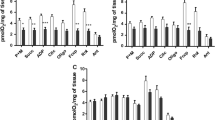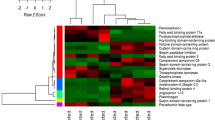Abstract
The effect of infection by Echinostoma paraensei on the activity of the enzymes alanine aminotransferase (ALT) and aspartate aminotransferase (AST) and the concentration of total proteins, uric acid and urea in the hemolymph of Biomphalaria glabrata were investigated after exposure to five or 50 miracidia. The biochemical concentrations were measured weekly until the end of the fourth week after exposure. There was a significant decrease in the concentrations of total proteins in the snails exposed both to five and 50 miracidia, as well as an increase in the nitrogenous products of excretion, ALT and AST activities. The higher ALT activity in the hemolymph of the snails after infection with 50 miracidia suggests highest energetic requirement in these snails in relation to snails exposed to five miracidia. The results also suggest an increase in the use of total proteins, since there was increased formation of nitrogenous catabolites, in conformity with an increase in the aminotransferase activities, frequently associated with tissue damages. This can be explained by damage due to penetration by the miracidia and subsequent development of intramolluscan sporocysts and rediae.





Similar content being viewed by others
References
Bandstra SR, Fried B, Sherma J (2006) High-performance thin-layer chromatographic analysis of neutral lipids and phospholipids in Biomphalaria glabrata patently infected with Echinostoma caproni. Parasitol Res 99:414–418
Becker W (1980) Metabolic interrelationship of parasitic trematodes and molluscs, especially Schistosoma mansoni in Biomphalaria glabrata. Z Parasitenkd 63:101–111
Becker W, Schmale H (1975) The nitrogenous products of degradation—ammonia, urea and uric acid—in the hemolymph of the snail Biomphalaria glabrata. Z Parasitenkd 51A:407–411
Bishop ML, Duben-Engelkirk JL, Fody EP (1996) Clinical chemistry. Principles, procedures, correlations, thirdth edn. Lippincott, Filadélfia
Blasco J, Puppo J (1999) Effect of heavy metals (Cu, Cd and Pb) on aspartate and alanine aminotransferase in Ruditapes philippinarum (Mollusca: Bivalvia). Comp Biochem Physiol C Pharmacol Toxicol Endocrinol 122:253–263
Connerty HV, Briggs AR, Eaten EH (1955) Determination of blood urea nitrogen using a simple stabilizing reagent. Am J Clin Pathol 25:1321
de Souza RM, Gomes EM, Chagas GM, Pinheiro J (2000) The Influence of starvation and Eurytrema coelomaticum infection on the nitrogenads produts of degradation in the hemolymph of Bradybaena similaris. Braz Arch Biol Technol 43:365–371
Fried B, Graczyk TK, Tamang L (2004) Food-borne intestinal trematodiases in humans. Parasitol Res 93:159–170
Hiong KC, Loong AM, Chew SF, Ip YK (2005) Increases in urea synthesis and the ornithine-urea cycle capacity in the giant African snail, Achatina fulica, during fasting or aestivation, or after the injection with ammonium chloride. J Exp Zool A Comp Exp Biol 303:1040–1053
Kaplan LA, Pesce AJ (1996) Clinical chemistry, Thirdth edn. Mosby, St. Louis
Lie KJ, Basch PF (1967) The life history of Echinostoma paraensei sp. n. (Trematoda: Echinostomatidae). J Parasitol 53:1192–1199
Lustrino D, Tunholi-Alves VM, Tunholi VM, Bessa ECA, Pinheiro J (2008) Allamanda cathartica (Apocynaceae) seeds induces changes on carbohydrates deposits of Bradybaena similaris (Mollusca, Bradybaenidae). Rev Bras Zooc 10:23–27
Maldonado A Jr, Vieira GO, Garcia JS, Rey L, Lanfredi RM (2001a) Biological aspects of a new isolate of Echinostoma paraensei (Trematoda: Echinostomatidae): susceptibility of sympatric snails and the natural vertebrate host. Parasitol Res 87:853–859
Maldonado A Jr, Loker ES, Morgan JAT, Rey L, Lanfredi RM (2001b) Description of the adult worms of a new Brazilian isolate of Echinostoma paraensei (Platyhelminthes: Digenea) from its natural vertebrate host Nectomys squamipes by light and scanning electron microscopy and molecular analysis. Parasitol Res 88:40–848
Maldonado A Jr, Coura R, Garcia JG, Lanfredi RM, Rey (2001c) Changes on Schistosoma mansoni (Digenea: Schistosomatidae) worm load in Nectomys squamipes (Rodentia: Sigmodontidae) concurrently infected with Echinostoma paraensei (Digenea: Echinostomatidae). Mem Inst Oswaldo Cruz 96:193–198
Maldonado A Jr, Gentile R, Fernandes CM, D’andrea PS, Lanfredi RM, Rey L (2006) Helminth communities of Nectomys squamipes (Rodentia: Sigmodontinae) naturally infected by the exotic trematode Schistosoma mansoni in southeastern Brazil. J Helminthol 80:369–375
Masola B, Chibi M, Kandare E, Naik YS, Zaranyika MF (2008) Potential marker enzymes and metal-metal interactions in Helisoma duryi and Lymnaea natalensis exposed to cadmium. Ecotoxicol Environ Saf 70:79–87
Massoud J (1974) The effect of variation in miracidial exposure dose on laboratory infections of Ornithobilharzia turkestanicum in Lymnaea gedrosiana. J Helminthol 48:139–144
Oliveira CS, Vasconcellos MC, Pinheiro J (2008) The population density effects on the reproductive biology of the snail Bradybaena similaris (Mollusca, Gastropoda). Braz J Biol 68:631–637
Perez MK, Fried B, Sherma J (1994) High performance thin-layer chromatographic analysis of sugars in Biomphalaria glabrata (Gastropoda) infected with Echinostoma caproni (Trematoda). J Parasitol 80:336–338
Pinheiro J, Amato SB (1994) Eurytrema coelomaticum (Digenea, Dicroceliidae): the effect of infection on carbohydrate contents of its intermediate snail host, Bradybaena similaris (Gastropoda, Xanthnychidae). Mem Inst Oswaldo Cruz 89:407–410
Pinheiro J, Amato SB (1995) Eurytrema coelomaticum: influence of the infection on the reproduction and nucleic acids contents in the albumen gland and ovotestis of Bradybaena similaris. Mem Inst Oswaldo Cruz 90:635–638
Pinheiro J, Gomes EM, Chagas GM (2001) Aminotranferases activity in the hemolymph of Bradybaena similaris under starvation. Mem Inst Oswaldo Cruz 96:1161–1164
Pinheiro J, Maldonado A Jr, Attias M, Lanfredi RM (2004a) Morphology of the rediae of Echinostoma paraensei (Trematoda: Echinostomatidae) from its intermediate host Lymnaea columella (Mollusca, Gastropoda). Parasitol Res 93:171–177
Pinheiro J, Maldonado A Jr, Lanfredi RM (2004b) Light and scanning electron microscopy of the miracidium of Echinostoma paraensei (Trematoda: Echinostomatidae). Vet Parasitol 121:265–275
Pinheiro J, Maldonado A Jr, Attias M, Lanfredi RM (2005) Ultrastructure of the Miracidium of Echinostoma paraensei Lie and Basch, 1967 (Trematoda, Echinostomatidae). Parasitol Res 97:367–372
Pinheiro J, Maldonado A Jr, Lanfredi RM (2009) Physiological changes in Lymnaea columella (Say, 1818) (Mollusca, Gastropoda) in response to Echinostoma paraensei Lie and Basch, 1967 (Trematoda, Echinostomatidae) infection. Parasitol Res 106:55–59
Sluiters JF, Brussaard-Wust CCM, Meuleman EA (1980) The relationship between miracidial dose, production of cercariae, and reproductive activity of the host in the combination Trichobilharzia ocellata and Lymnaea stagnalis. Z Parasitenkd 63:13–26
Théron A, Moné H, Gérard C (1992) Spatial and energy compromise between host and parasite: the Biomphalaria glabrata-Schistosoma mansoni system. Int J Parasitol 22:91–94
Thompson SN, Mejia-Scales V, Borchardt DB (1991) Physiologic studies of snail-schistosome interactions and potential for improvement of in vitro culture of schistosomes. In Vitro Cell Dev Biol 27A:497–504
Tunholi VM, Lustrino D, Tunholi-Alves VM, Mello-Silva CC, Maldonado A Jr, Rodrigues MD, Pinheiro J (2010) Changes in the reproductive biology of Biomphalara glabrata infected with different doses of Echinostoma paraensei miracidia. J Invertebr Pathol. doi:10.1016/j.jip.2010.09.006
Vasquez RE, Sullivan JT (2001) Effect of miracidial dose on adoptively transferred resistance to Schistosoma mansoni in the snail intermediate host, Biomphalaria glabrata. J Parasitol 87:460–462
Weichselbaum CTE (1946) An accurate and rapid method for determination of proteins in small amounts of blood serum and plasma. Am J Clin Pathol 16:40–49
Acknowledgments
This study was supported in part by Conselho Nacional para o Desenvolvimento Científico e Tecnológico (CNPq) and Fundação Carlos Chagas Filho de Amparo à Pesquisa do Estado do Rio de Janeiro (FAPERJ). The authors thank M.Sc. Juberlan Silva Garcia for technical assistance.
Author information
Authors and Affiliations
Corresponding author
Rights and permissions
About this article
Cite this article
Tunholi, V.M., Lustrino, D., Tunholi-Alves, V.M. et al. Biochemical profile of Biomphalaria glabrata (Mollusca: Gastropoda) after infection by Echinostoma paraensei (Trematoda: Echinostomatidae). Parasitol Res 109, 885–891 (2011). https://doi.org/10.1007/s00436-011-2330-7
Received:
Accepted:
Published:
Issue Date:
DOI: https://doi.org/10.1007/s00436-011-2330-7




